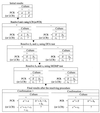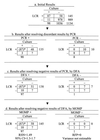Relative accuracy of nucleic acid amplification tests and culture in detecting Chlamydia in asymptomatic men
- PMID: 11682509
- PMCID: PMC88466
- DOI: 10.1128/JCM.39.11.3927-3937.2001
Relative accuracy of nucleic acid amplification tests and culture in detecting Chlamydia in asymptomatic men
Abstract
Published estimates of the sensitivity and specificity of PCR and ligase chain reaction (LCR) for detecting Chlamydia trachomatis are potentially biased because of study design limitations (confirmation of test results was limited to subjects who were PCR or LCR positive but culture negative). Relative measures of test accuracy are less prone to bias in incomplete study designs. We estimated the relative sensitivity (RSN) and relative false-positive rate (RFP) for PCR and LCR versus cell culture among 1,138 asymptomatic men and evaluated the potential bias of RSN and RFP estimates. PCR and LCR testing in urine were compared to culture of urethral specimens. Discordant results (PCR or LCR positive, but culture negative) were confirmed by using a sequence including the other DNA amplification test, direct fluorescent antibody testing, and a DNA amplification test to detect chlamydial major outer membrane protein. The RSN estimates for PCR and LCR were 1.45 (95% confidence interval [CI] = 1.3 to 1.7) and 1.49 (95% CI = 1.3 to 1.7), respectively, indicating that both methods are more sensitive than culture. Very few false-positive results were found, indicating that the specificity levels of PCR, LCR, and culture are high. The potential bias in RSN and RFP estimates were <5 and <20%, respectively. The estimation of bias is based on the most likely and probably conservative parameter settings. If the sensitivity of culture is between 60 and 65%, then the true sensitivity of PCR and LCR is between 90 and 97%. Our findings indicate that PCR and LCR are significantly more sensitive than culture, while the three tests have similar specificities.
Figures












References
-
- Centers for Disease Control and Prevention. Recommendations for the prevention and management of Chlamydia trachomatis infections. Morb Mortal Wkly Rep. 1993;42(RR-12):1–39. - PubMed
-
- Cheng H, Macaluso M. Comparison of the accuracy of two tests with a confirmation procedure limited to positive results. Epidemiology. 1997;8:104–106. - PubMed
-
- Cheng H, Macaluso M, Hardin M. Validity and coverage of estimates of relative accuracy. Ann Epidemiol. 2000;10:251–260. - PubMed
Publication types
MeSH terms
Substances
LinkOut - more resources
Full Text Sources
Medical

